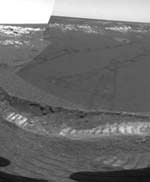
Image credit: NASA/JPL
If you’re a geologist, you always keep a shovel handy. One of the best ways to understand the geologic history of an area is to dig down and examine the layers of material. NASA’s rovers couldn’t bring a shovel to Mars, but they still have a way to get a look down under the surface – they can dig a trench with their wheels.
Engineers perfected a technique here on Earth where the twin Mars Exploration Rovers lock up five of their six wheels and turn the sixth to excavate a trench down into the Martian soil. Depending on the kind of dirt, this “shovel” can get down more than 10 cm, and reveal the deeper layers.
And today, NASA’s Opportunity rover did just that.
The rover used its right front wheel to dig a trench into the soil at an area called Hematite ridge. After the rover completed the operation, engineers were able to confirm that it had scooped out dirt approximately 8 to 10 cm deep and 20 cm wide. The rover’s hazard cameras confirmed that the subsurface soil is much brighter than the dark-red topsoil.
The area was selected because it’s rich in hematite; a mineral on Earth which usually forms in the presence of liquid water (although, it can be created through volcanic processes as well).
With the deeper soil on the surface, the rover can now use its suite of scientific instruments to measure the soil, to help scientists get a better idea of what could have deposited the hematite.
Once Opportunity completes its analysis of the trenched soil, it will make its way to a site called El Capitan, which is part of a rock outcrop on the side of the crater that the rover landed inside.
